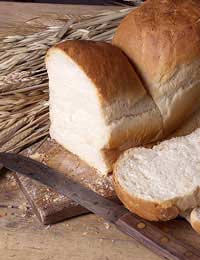Making Bread From Scratch

Baking your own bread is a great way to stretch the budget. Don’t be put off by the complexity of bread baking: once you’ve got the basics, you’ll be able to make a loaf in an evening. Short on time as well as budget? Why not look at a bread machine, or check out our recommended recipe that requires no kneading whatsoever.
Ingredients for Bread
Bread is a truly simple food. It’s made from four basic ingredients: flour, yeast, salt, and water. You will see recipes that also contain sugar (to speed up the yeast’s action) and oil or butter (to improve the keeping quality of the bread). But tradition dictates the use of only four ingredients. Here’s how they work:FLOUR. It is important to start with strong white bread flour – not plain white flour – because this gives a higher gluten content and a lighter loaf.
YEAST. Obviously, this is responsible for the rise of your loaf. Yeast feeds on natural sugars (present in flour’s starch molecules) to produce carbon dioxide. This natural gas gives bread its fluffy, holey quality. You can use fresh, dried or instant yeast in your baking – read the instructions on the package to see how to use it. Dried instant yeast is easy to incorporate in a bread machine dough, or the No-Knead recipe (information below).
SALT. This has three jobs: to inhibit fermentation (which sounds odd, but a little slow-down allows the flour gluten to stretch slowly, giving a stable structure at the end), to improve keeping, and to improve the taste. Most bread recipes give the amount for table salt; if you are substituting coarse or sea salt, use a bit more, because it contains less sodium.
WATER. Of course, water binds the dough together. Use lukewarm water, or mix half fresh-boiled and half cold water in a cup. If your water is too hot, the yeast’s action will be inhibited or stopped.
Bread Machines
If baking your own bread sounds like a chore – but you’d still like to save on your food budget – consider investing a little in a Bread Machine.A good model costs around £90. How will that help your budget? Because once you’ve paid for the initial outlay, you can make a loaf for 40p or less. Choose a machine that has the options you need – for instance, would you prefer wholemeal bread? Do you intend to use it to bake loaves or prepare dough for rolls, biscuits or pizza? Would you like a ‘cake’ option too? Most good machines feature timers, so you can put in the ingredients and set the time you’d like the bread to be ready. Your machine will probably also arrive with a handbook of basic recipes to get you started. It’s as easy as that!


Re: Cooking and Freezing in Bulk
Many thanks for your response, that is extremely helpful even if a little complicated. I have printed this article and will pass…
Re: Cooking and Freezing in Bulk
@ Iain beg McAndrew - I think Delia refers to a 'buttery kedgeree' which isn't suitable for freezing because it is too oily. I…
Re: Cooking and Freezing in Bulk
You say that kedgeree is suitable for freezing, Delia says that it is not. As I am preparing a buffet for some 20 and wish to…
Re: Cookery Group Topics to Cover & Consider
Those are all great activities, but you can also offer to provide dishes for other groups, say for a bake…
Re: Meals for Five Pounds or Less
Cool, but, I'm looking for snacks, not meals, that you don't use an oven for (ours is broken). (but Microwaves are fine)